Human Trafficking Statistics By Age, Venue, Type and Region – Enterprise Apps Today
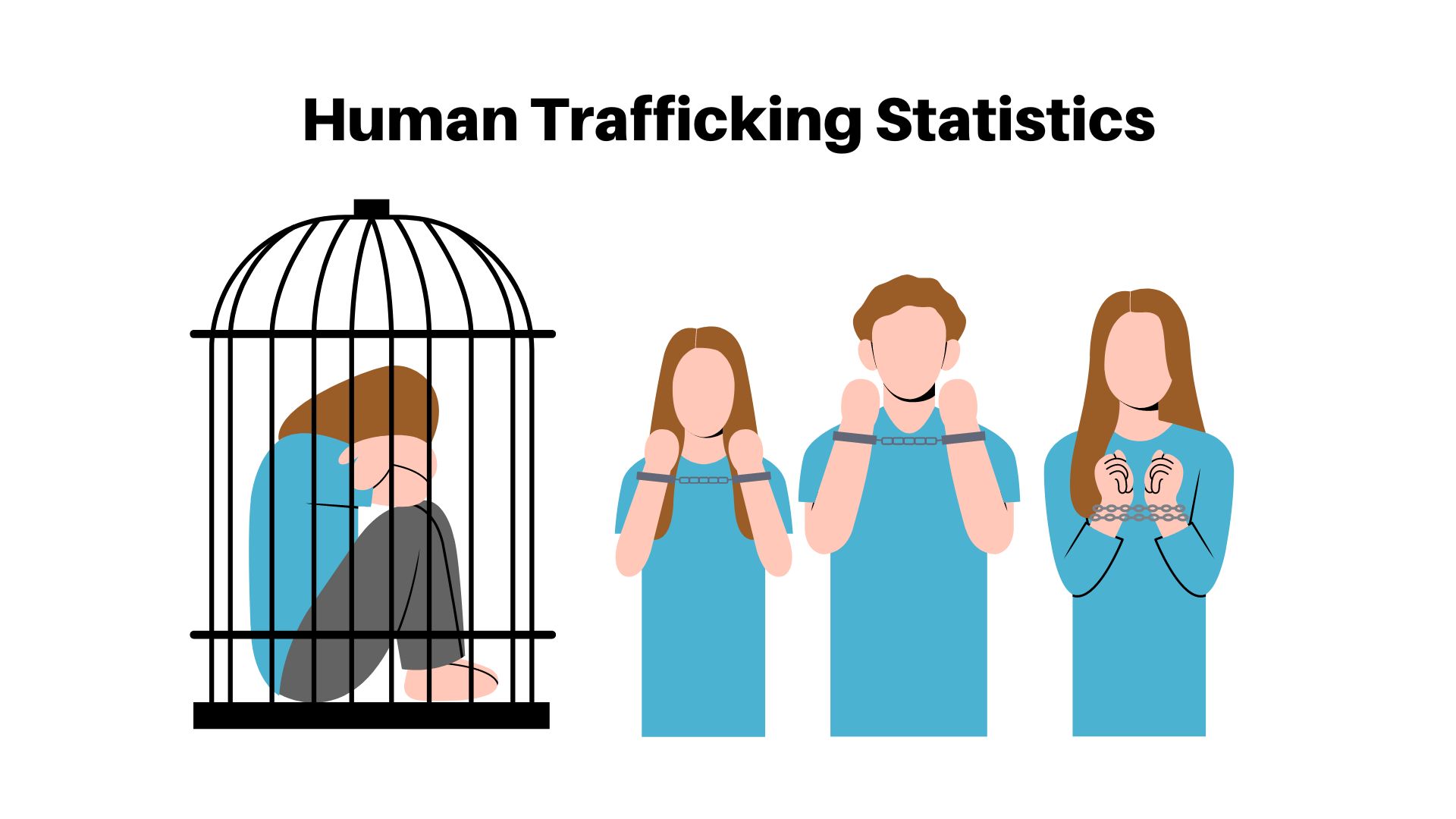
Introduction
Human Trafficking Statistics: Today, we reside in a modern world but yet there is not a single day when illegal activities do not happen. Unfortunately, illegal activities are focused more on girls and women. Sexual violence in such cases badly affects their physical, emotional as well as mental health. And surprisingly, even developed countries face likewise issues. Someday, we need to see a world without any such activities, but it is not suddenly possible unless the government and residents look at it more actively.
With the unfortunate events, this Human trafficking statistics have been written including various sectors, regions, demographics, and many more insightful topics.
Editor's Choice
- Every year 4.5 billion people become the victims of forced sex trafficking.
- 2 out of 3 immigrants become victims irrespective of the international travel method.
- Human trafficking statistics say that there are 5.4 victims related to modern slavery for every 1000 people in the globe.
- The estimated number of victims stuck in modern-day slavery (40.3 million) out of these forced labor reported to have 24.9 victims and forced marriage (15.4 million).
- Around 16.55 million reported human trafficking cases have happened in the Asia Pacific.
- Out of 40 million victims of human trafficking, 25% are children around the globe.
- The highest ever forced labor trafficking cases are reported to happen in domestic work resulting in 30%.
- Human trafficking statistics say that the person who performs the crime earns illegally $150 billion every year.
- Around the globe, the sex trafficking industry is larger than the worldwide cocaine market.
- Only 0.4% of survivors of human trafficking cases are detected.
What is human trafficking?
Human trafficking refers to the illegal trade of human beings, regardless of age or gender, for sexual slavery, forced labor, and other sexual activities. These cases can occur in any country, but also internationally. These types of cases can be found not only in developing countries but also in developed and underdeveloped countries. Human trafficking is the biggest industry worldwide. It is crucial to report cases of human trafficking to authorities in order to reduce illegal activities.
General Human Trafficking Statistics
- According to statistics on human trafficking, there are 5.4 modern slavery victims for every 1000 people.
- The most widespread form of trafficking is sex trafficking, followed by forced labor which results in 79% and 18% respectively.
- Human trafficking statistics show that the victim of the crime is illegally earning $150 billion annually.
- It is estimated that there are 40.3 million victims of modern-day slavery. This includes 24.9 victims of forced labor and 15.4 million victims of forced marriage).
- The sex trade in sex is more lucrative than the global cocaine market.
- According to statistics, 35 million victims are sex trafficked every day worldwide.
- Each year, 4.5 billion people are victims of the forced sex trade.
- Only 0.4% are found to be survivors of human trafficking cases.
- A victim trapped in this situation once is likely to live for 7 years.
- Globally, the average price of a human slave in this country is $90
- Statistics on human trafficking show that approximately 50% of all cases are in the United States.
- Sex trafficking is more common in women than it is in men.
By Country
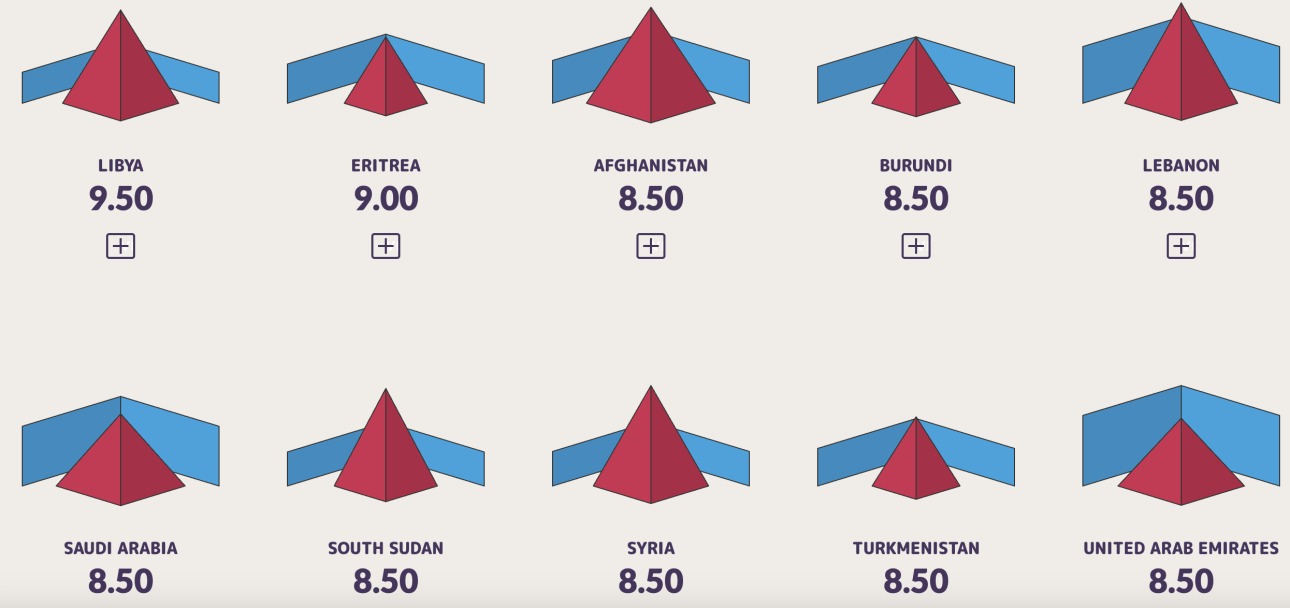
(Source: ocindex.net)
- As of 2022, Human trafficking statistics show that Libya ranks first for having a. 9.50 score out of 10 for the most similar cases.
- Eritrea, Afghanistan, and Burundi have a rate of 9, 8.50 each.
- Other countries with an equal score for similar cases are Lebanon, Saudi Arabia, South Sudan, Syria, Turkmenistan, and United Arab Emirates (8.50).
By Immigrants
- 5% of international victims reported having crossed the borders by illegal means.
- Considering the international stage, 44% of children became victims by crossing borders officially.
- 2 out of 3 immigrants become victims irrespective of the international travel method.
- 15% of the victim travelers were from various regions, and 12% were from the same sub-region.
- 15% of cases have been reported to happen interregional.
By Region
Forced Labor Cases
- Around 16.55 million reported human trafficking cases have happened in the Asia Pacific.
- 42 million cases belong to Africa and 3.25 cases are from Europe and Central Asia regions respectively.
- And in the American region, the reported forced labor cases are 1.28 million.
Sexual Trafficking Cases
South America (Argentina, Brazil, Uruguay, Bolivia, Ecuador, Bolivia, Peru, Surinam, Guyana, Colombia, and Venezuela).
- 92% of cases observed. 72% of the victims are females and 28% are males.
- The majority of the people victims are 73% and the minors are 27%.
Central America (Caribbean Islands, Cuba, Nicaragua, Costa Rica, Mexico, Guatemala, Honduras, and Panama)
- 65% of victims are females and 35% are males.
- 5% of cases are observed in these cities for sex trafficking.
- 52% of victims belong to adult age and 48% are minors.
North America (Canada, Greenland, and USA)
- Sex trafficking cases are found at 52.36% in these countries.
- Out of these, 84% are females, 15% are males and 1% are transgender.
- The reported number of Adults and minors is 70% and 30% respectively.
South-Eastern Asia (Vietnam, Singapore, Timor- Leste, Cambodia, Myanmar, Laos, Malaysia, Indonesia, and Thailand.)
- 97% of sex trafficking cases.
- 82% of victims are adults and 18% are minors.
- The ratio of females and males is 54% and 46% respectively.
Eastern Asia (Taiwan, South Korea, North Korea, Macau, Mongolia, Japan, China, and Hong Kong).
- Only 1.29% of such reported cases are found in the above countries.
- 86% and 14% are female and male victims.
- 96% of cases are experienced by adults and 4% are by minors.
Central Asia (Uzbekistan, Turkmenistan, Tajikistan, Kyrgyz Republic, and Kazakhstan)
- Observed cases: 2.62%
- The adult ratio of trapped people is 95% and 5% are minors.
- Female and male reported cases are 51% and 49% respectively.
Southern Asia (Bangladesh, Bhutan, Nepal, Sri Lanka, Nepal, Afghanistan, and India)
- The observed rate of sexual trafficking in these countries is 1.02%.
- Out of these 59% are females and 42% are males.
- And with some minor differences adults and minors trapped in such cases are 53% to 47%.
Western Asia (Bahrain, Iraq, Kuwait, Oman, The State of Palestine, Lebanon, UAE, Yemen, Saudi Arabi, and Qatar).
- The observed rate of sexual trafficking: is 5.98%.
- Targeted gender rate: 90% females and 10% males.
- Age-wise distribution: 97% adults and 3% minors.
Central Africa (Sao Tome and Principe, Democratic Republic of Congo, Chad, Congo Republic, Central Africa Republic, Cameroon, Gabon, and Equatorial Guinea)
- The observed rate of sexual trafficking: is 0.5% (not confirmed)
- Targeted gender rate: 67% females and 33% males.
- Age-wise distribution: 53% adults and 47% minors.
Southern Africa (Zimbabwe, Swaziland, South Africa, Angola, Botswana, Lesotho, Mozambique, and Namibia)
- The observed rate of sexual trafficking: is 0.5%
- Targeted gender rate: 61% females and 39% males.
- Age-wise distribution: 85% adults and 15% minors.
Western Africa (Togo, Sierra Leone, Senegal, Guinea- Bissau, Liberia, Mali, Gambia, Cote, Cape, Benin, Burkina Faso, Nigeria, Mauritania, Cote D'lvoire, and Niger)
- The observed rate of sexual trafficking: is 2.81%
- Targeted gender rate: 63% females and 37% males.
- Age-wise distribution: 59% adults and 41% minors.
Eastern Africa (Uganda, Mauritius, Malawi, Comoros, Burundi, Kenya, Ethiopia, Eritrea, Djibouti, Somalia, Somaliland, Seychelles, Tanzania, Madagascar, Rwanda, and Reunion)
- The observed rate of sexual trafficking: is 1.45%
- Targeted gender rate: 65% females and 35% males.
- Age-wise distribution: 69% adults and 31% minors.
Southern Europe (Montenegro, Kosovo, Serbia, Greece, Albania, Italy, Spain, Portugal, and Serbia)
- The observed rate of sexual trafficking: is 3.13%
- Targeted gender rate: 88% females and 12% males.
- Age-wise distribution: 89% adults and 11% minors.
Eastern Europe (Slovakia, Romania, Belarus, Ukraine, Poland, Russia, Hungary, and Czech Republic)
- The observed rate of sexual trafficking: is 14.07%
- Targeted gender rate: 53% females and 43% males.
- Age-wise distribution: 92% adults and 8% minors.
Northern Europe (Lithuania, Estonia, Iceland, Finland, Denmark, Norway, Great Britain, and Sweden)
- The observed rate of sexual trafficking: is 0.81%
- Targeted gender rate: 58% females and 41% males.
- Age-wise distribution: 94% adults and 6% minors.
Western Europe (Monaco, Austria, Switzerland, Belgium, France, Netherlands, and Germany)
- The observed rate of sexual trafficking: is 1.09%
- Targeted gender rate: 78% females and 22% males.
- Age-wise distribution: 94% adults and 6% minors.
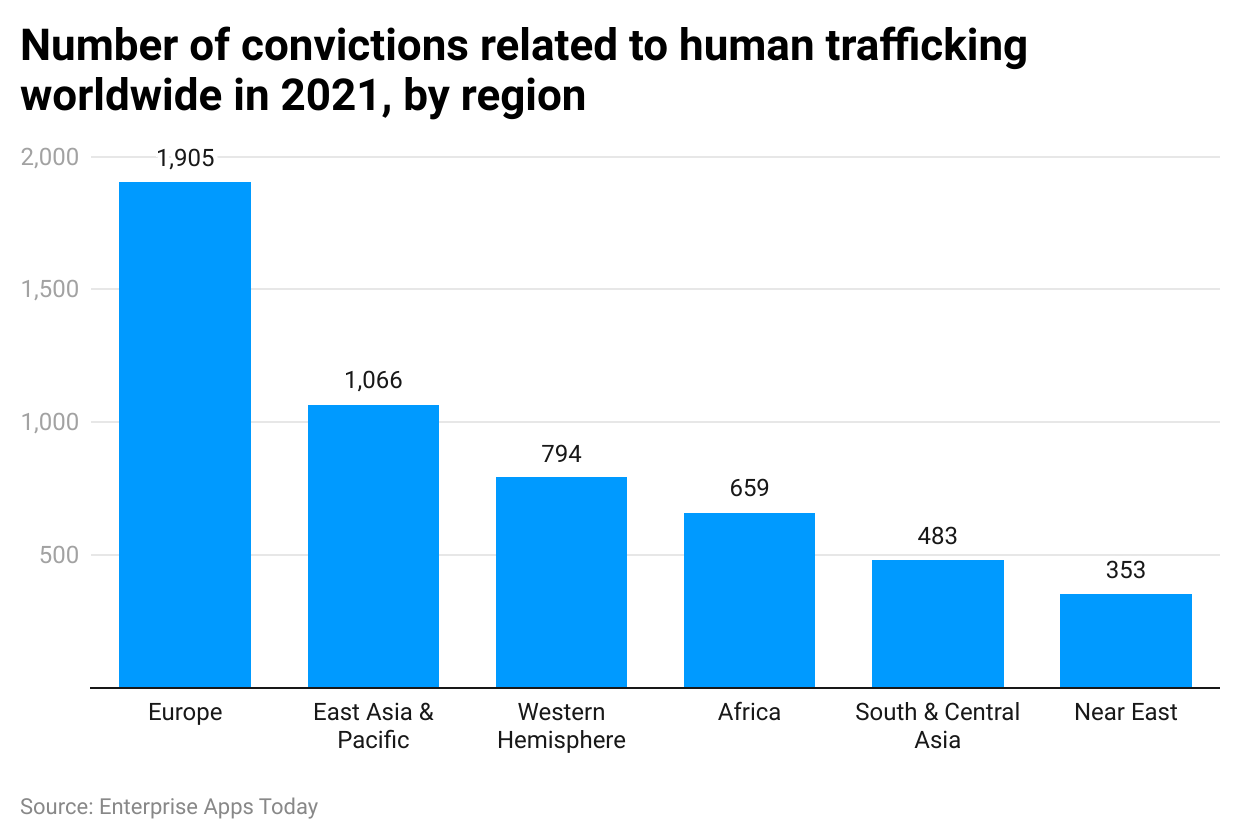 (Reference: Statista.com)
(Reference: Statista.com)
- As of 2021, the Europe region recorded around 1,905 convictions relating to human trafficking cases.
- East Asia and Pacific and Western Hemisphere contributed around 1,066 and 794 respectively.
- 659, 483, and 353 convictions were observed in Africa, South and Central Asia, and Near East.
By Industry
- 8% of the forced labor trafficking cases happen in the hospitality industry.
- While 9% belong to manufacturing and 10% cases are from the agriculture industry.
- 16% of the cases occur in the construction industry.
- And the highest ever forced labor trafficking cases are reported to happen in domestic work resulting in 30%.
By Demographics
- Around the globe, 71% of victims are girls and women and 29% are boys and men.
- 2 million victims are at the age of 18 years resulting in 75%, and children below 18 resulted in 10.1 million with 25%.
- Out of 40 million victims of human trafficking, 25% are children around the globe.
- 1 out of 4 victims are children who suffer modern slavery.
- The average of victims in children is between 12 to 14 years.
- On average, a child is sold for sex purposes 20 to 30 times every day.
- Social media has become a part of the human trafficking cause in children.
By Gender
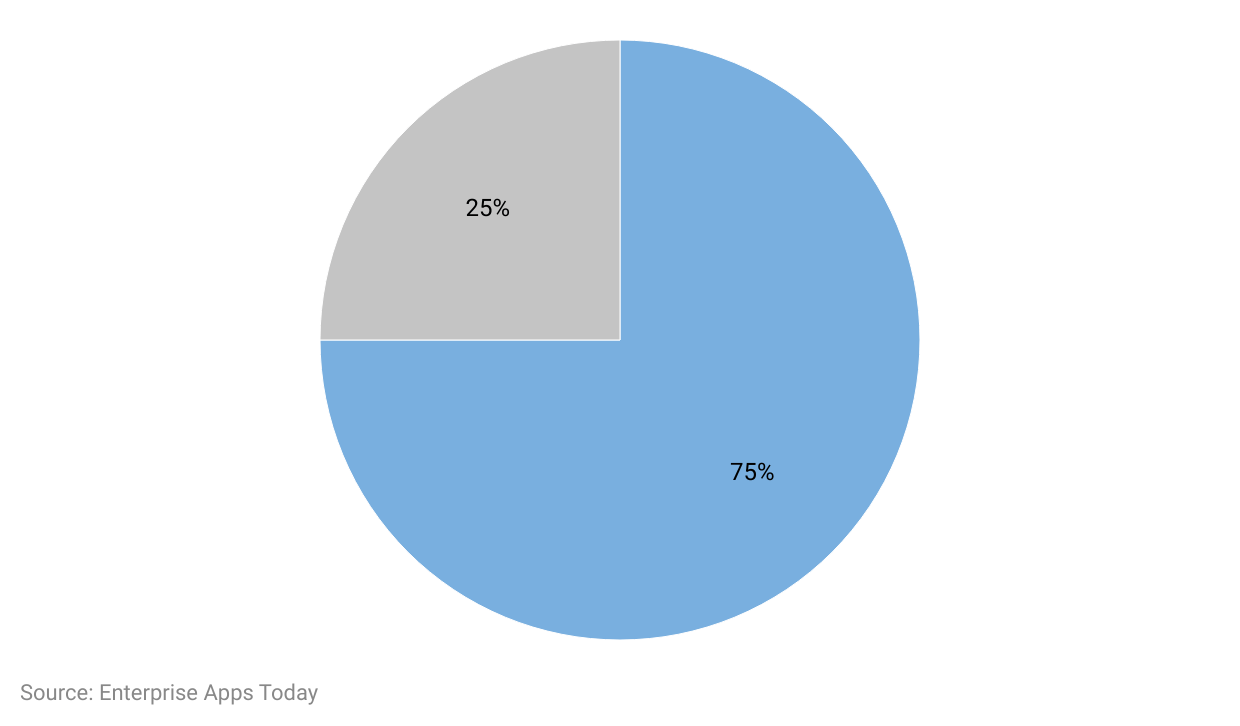 (Reference: NEAL DEVIS)
(Reference: NEAL DEVIS)
- Human trafficking statistics reveal that 75% of the cases are around women.
- And 25% of cases belong to the male population.
By Relationship
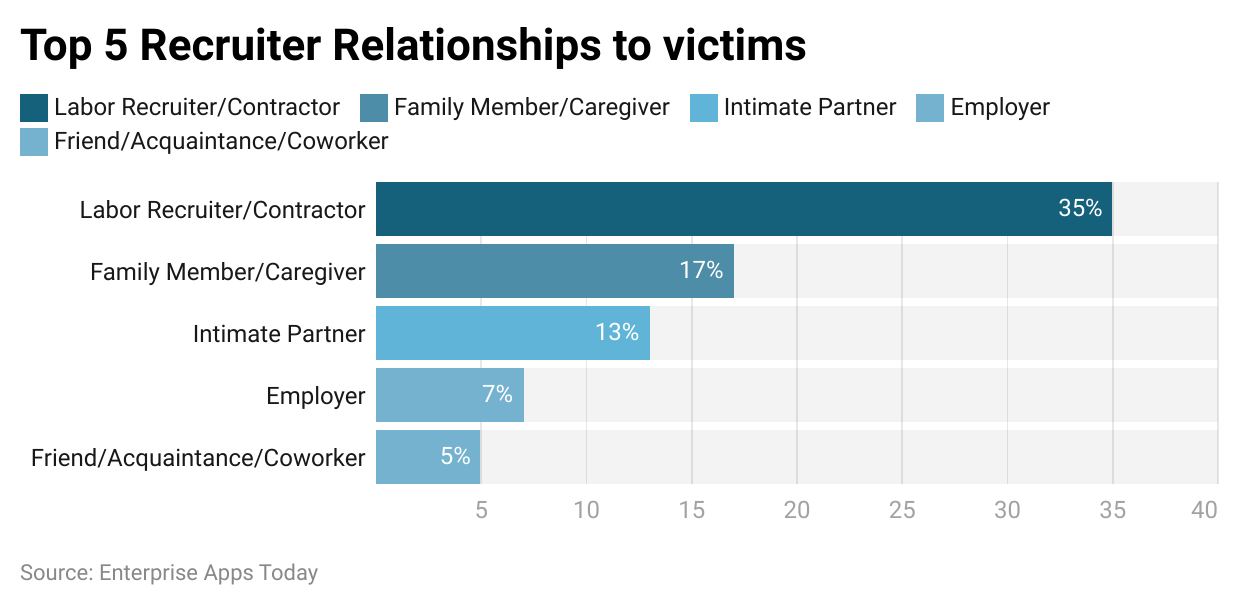 (Reference: South Carolina Attorney General)
(Reference: South Carolina Attorney General)
- The top 5 recruiter cases with victims following human trafficking are Labor recruiter or contractor resulting in 35%.
- Family members/caregivers contribute to such cases by 17%.
- And 13%, 7%, and 5% of cases are observed by an intimate partner, employer, and friend/acquaintance/Coworker respectively.
By Methods
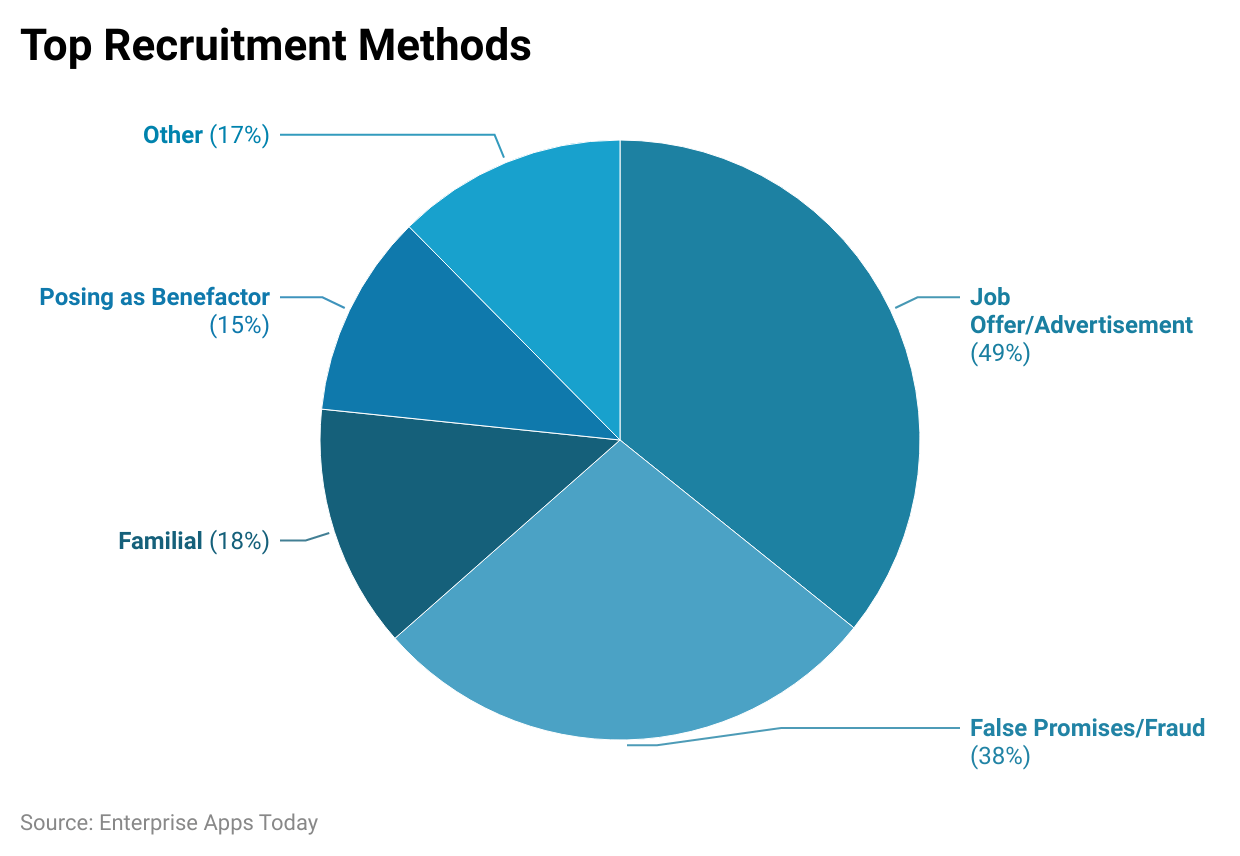 (Reference: South Carolina Attorney General)
(Reference: South Carolina Attorney General)
- Traffickers use various victims to trap innocent people, the most common method used is a Job offer or advertising resulting in 49%.
- 38% of the cases occurred from false promises/fraud resulting in 38%.
- 18% of human trafficking cases are observed in the familial method.
- 15% and 14% belong to posing as a benefactor and intimate partner/ marriage proposition respectively.
- And 3% are abduction cases.
By States
By Highest
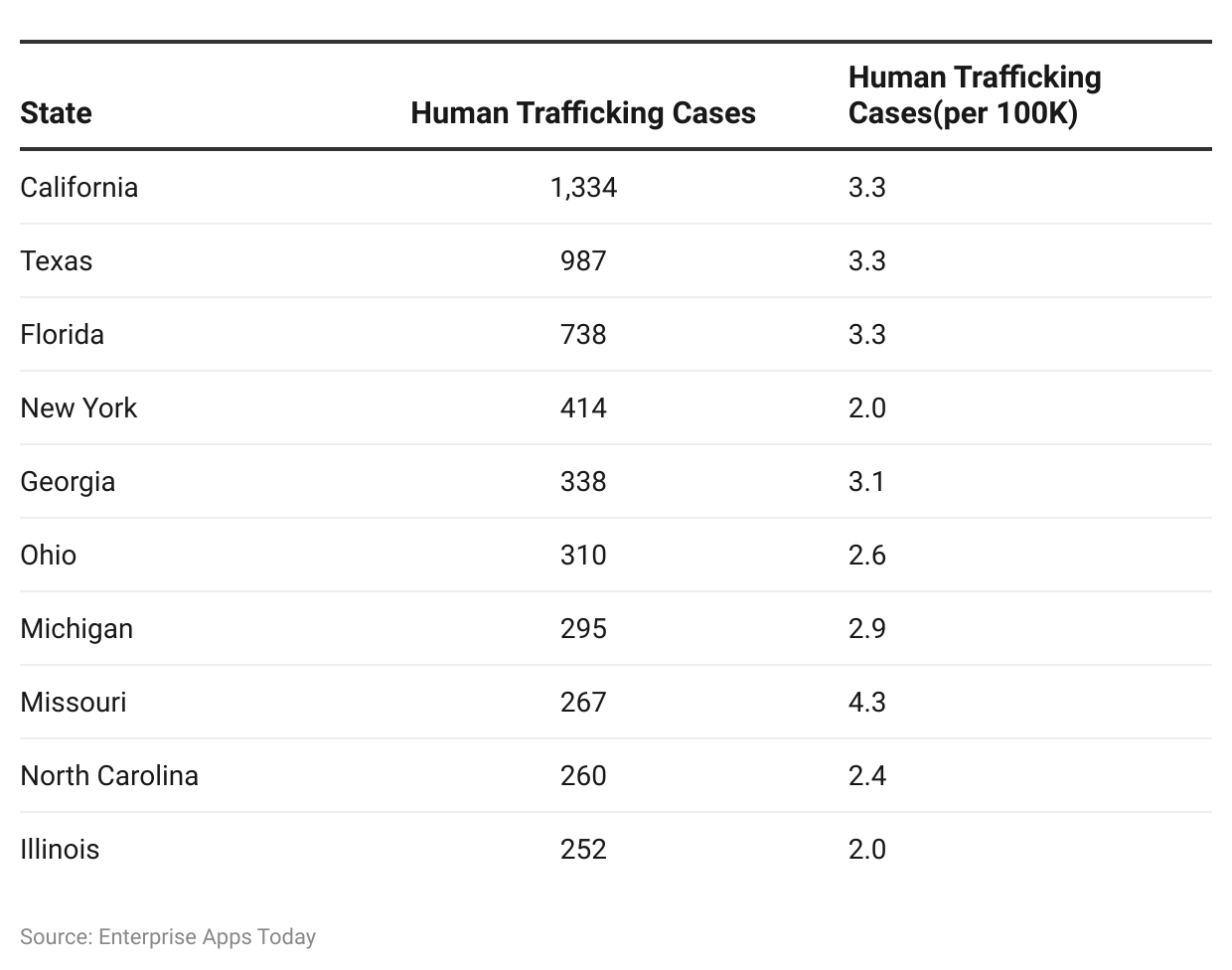 (Reference: World Population Review.com)
(Reference: World Population Review.com)
- According to Human trafficking statistics, California recorded the highest number of cases resulting in 1,334 at 3.32% for every 100K people.
- Texas and Florida have 987 and 738 recorded cases resulting in 3.25% and 3.30% respectively for every 100K of the population.
- Other states in the United States of America in 2022 recorded the following number for every 100K people: New York 414 cases (2.02%), Georgia 338 cases (3.07%), Ohio 310 cases (2.61%), Michigan 295 cases (2.91%), Missouri 267 cases (4.30%), North Carolina 260 cases (2.43%), and Illinois 252 cases (1.97%).
By Lowest
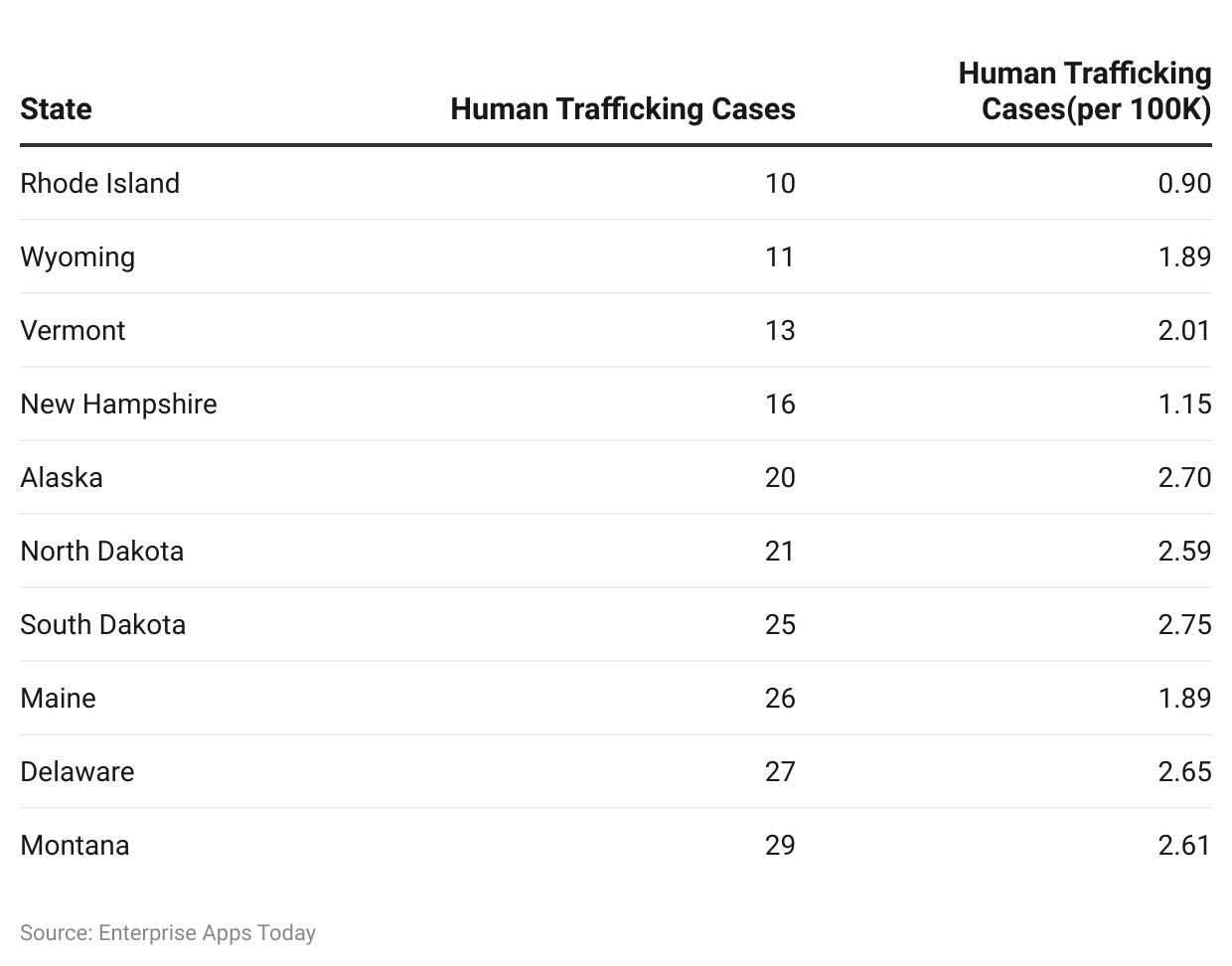 (Reference: World Population Review.com)
(Reference: World Population Review.com)
- The lowest cases of Human trafficking in the year 2022 were observed in Rhode Island, United States of America resulting in 10 cases for every 1000K population. The rate of such cases is the lowest of all observed at 0.90.
- Wyoming and Vermont ranked respectively following the 11 and 13 cases with 1.89% and 2.01% each for the 1000K population.
- Other states in the United States of America with the lowest human trafficking case are New Hampshire 16 cases (1.15%), Alaska 20 cases (2.70%), North Dakota 21 cases (2.59%), South Dakota 25 cases (2.75%), Maine 26 cases (1.89%), Delaware 27 cases (2.65%), and Montana 29 cases (2.61%).
By Type
- The forced labor industry earns around $43.2 billion illegally every year.
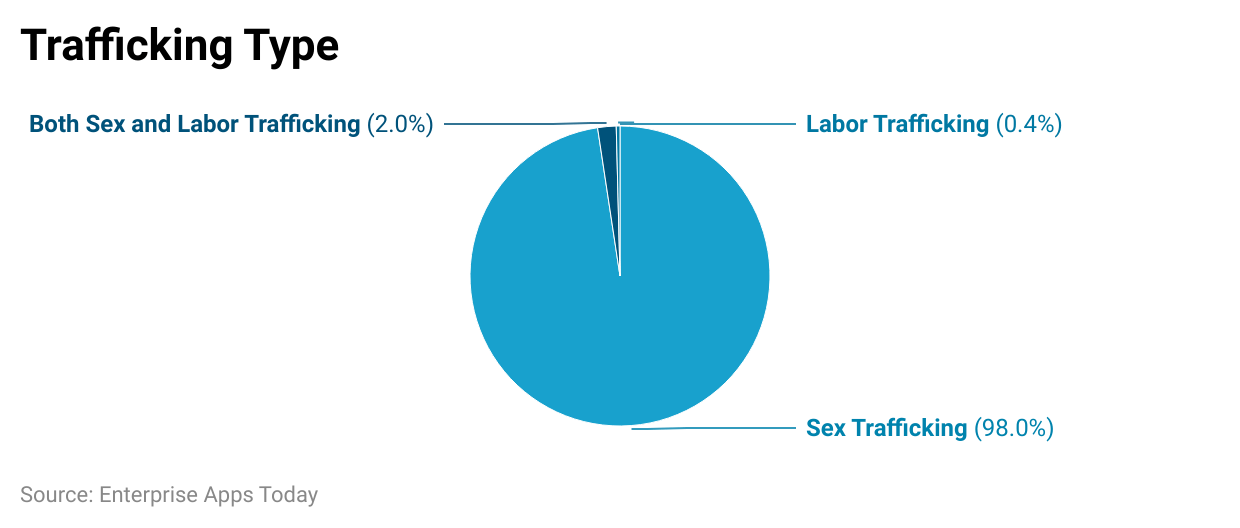 (Reference: South Carolina Attorney General)
(Reference: South Carolina Attorney General)
- The major illegally conducted type of human trafficking around the globe is sex trafficking resulting in 98%.
- Only 0.40% of cases are found for labor trafficking alone.
- And 2% of cases belong to both sex and labor trafficking suffered by an individual.
Sex Trafficking By Venue
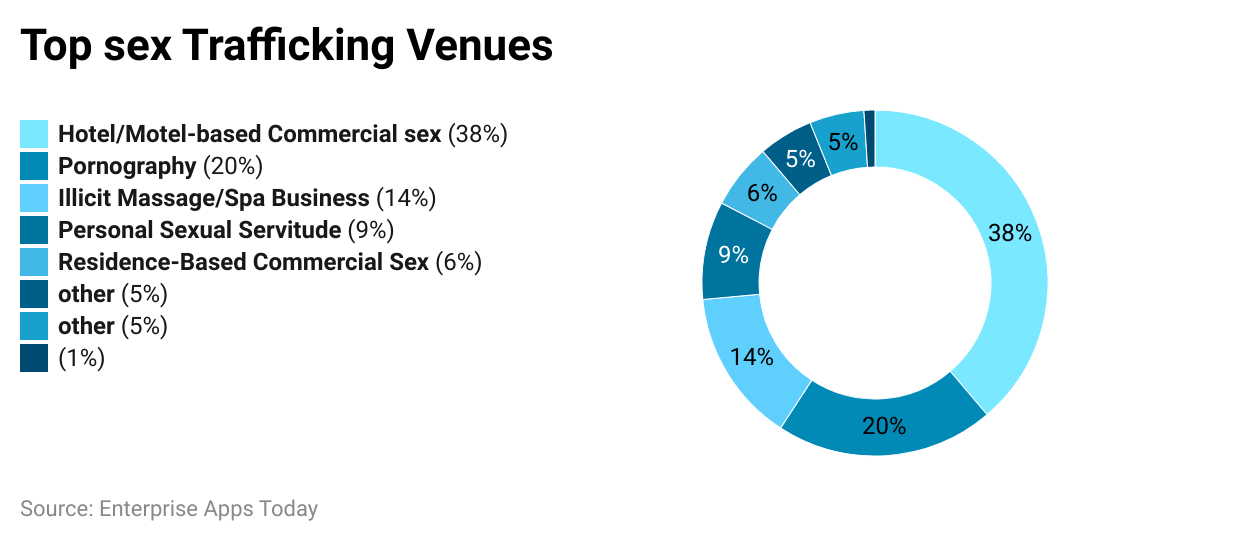 (Reference: South Carolina Attorney General)
(Reference: South Carolina Attorney General)
- The top sex trafficking venue as per the human trafficking statistics for illegal sexual acts is hotel/motel-based commercial sex resulting in 38%.
- The venues where pornography is conducted have a 20% of ratio and illicit massage or Spa businesses contribute to top sex trafficking venues by 14%.
- 9% of venues belong to personal sexual servitude and 5% each for residence-based commercial sex and other places.
| SIGNALER'S METHOD OF COMMUNICATION | POTENTIAL VICTIMS |
|---|---|
| Hotline call | 68% |
| SMS Report | 26% |
| Email Received | 4% |
| Online Report | 1% |
| Webchat | 1% |
(Reference: humantraffickinghotline.org)
- According to the Human trafficking statistics of 2021, the highest number of complaints received for such cases was via Hotline resulting in 68%.
- 26% of the victim's or signaler's method of communication was SMS report.
- 4% of the complaint were received from email while 1% were reported from online reports and webchat respectively.
Myths of human trafficking
- Every human trafficking case involves sex.
- Human trafficking is usually a violent crime.
- Only girls and women become victims of sex trafficking.
- Such cases occur only in underground industries or happen illegally.
- Human trafficking always involves transporting, traveling, or moving the victims out of the country.
- In developing countries, human trafficking is the primary problem.
- Every commercial sex is called human trafficking.
- People already stuck in these places are always willing to help the new victim.
- Victims are always locked in or stuck in unknown places forever.
Conclusion
The sad reality of the world comes in front of the eyes while concluding this Human Trafficking statistics. As a part of the modern world, we need to take some appropriate steps to stop these illegal activities. As a measure, the government may implement some strict actions and promote cultural activities. Moreover, from childhood, boys, and girls must be educated about the well-being of humanity.
Who is the biggest human trafficker?
Donald Eugene Fields II is the biggest human trafficker who was arrested for sex and child trafficking as well as rape records in his name.
How common is human trafficking?
Every year around 27.8 million people of various gender, backgrounds, nationalities, and ages become victims of such cases. Moreover, due to excessive use of social media, such cases are rising at a high level.
Where to report seen human trafficking?
You can report human trafficking cases to the nearest police station of the designated place you have experienced or seen the case.

Barry is a lover of everything technology. Figuring out how the software works and creating content to shed more light on the value it offers users is his favorite pastime. When not evaluating apps or programs, he's busy trying out new healthy recipes, doing yoga, meditating, or taking nature walks with his little one.
